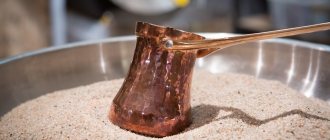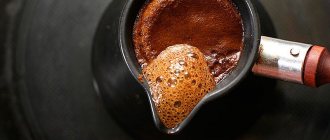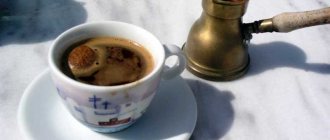The taste and aroma qualities of a coffee drink depend primarily on the type of beans chosen. Also, these characteristics are influenced by what the coffee is brewed in. There are several types of cookware and devices that can be used. To achieve good results, it is extremely important to choose these devices correctly.
What is coffee usually brewed in?
There is more than one name for cookware for making coffee. In the United States of America alone, about eight hundred patents have been issued for various variations of coffee makers. Essentially, all these devices are divided into two types:
- electrical;
- slab
Slabs require heating. The dishes are placed on the stove. Electric ones simply need to be connected to the mains.
There are both simple devices that have been used for centuries, and modern units that perform many functions, including grinding beans and choosing the optimal dosage.
Review of prices and manufacturers
Various metal Turks made of cupronickel, silver and copper are produced by Stanitsa; the Russian company specializes mainly in “gift” models - these can be either single cezves or full-fledged Turkish sets; the cost of copper Turks rarely exceeds 1000 rubles.
A budget but high-quality option is the Turkish Gorenje TCM 300W. The bowl body is made of plastic and stainless steel, the handle is removable and completely made of plastic, as is the heating stand. There is only one button, there is no auto-shut-off function, and coffee can be prepared in a minute or a minute and a half. The cost of the model ranges from 1600 to 2000 rubles.
Cooking in Turk
The oldest and simplest way to prepare a coffee drink, which is still widely used today, is boiling the beans in a Turk (cezve). Already from the name it becomes clear that this dish was invented in eastern countries. They initially used ordinary saucepans to brew the drink, and then for convenience they decided to remove one of the handles. The one that remained was made longer, curved and flattened.
Over time, the Arabs noticed that if the container at the neck was made narrower and the edges widened, the coffee would be much tastier. Thus, dishes with a thickened bottom, a narrow neck and a long handle were invented. She quickly gained popularity all over the world.
Nowadays, Turkish coffee is prepared on a stove (gas or electric). The classic recipe involves brewing in hot sand. The following actions are performed:
- The sand is heated for several hours.
- A Turk filled with coffee and water is immersed in it up to the level of the neck.
- When the water approaches the point of boiling, the cezve is quickly removed.
- To fully develop the taste and aroma, such manipulations are repeated 3-4 times.
For those who like to prepare a drink according to the classic recipe, a special electrical appliance has been developed. Visually, it resembles a box filled with sand. When it is turned on, the contents of the container become hot. All that remains is to place the cezve there.
If you have no experience in making coffee, it is recommended to start mastering this process with a copper or ceramic Turk.
Initially, only one type of grain is used. Then you can switch to mixtures and add various spices to the composition.
Chemex
Cost of equipment: from 2000-2500 rubles for a flask and 800-1000 rubles for filters; Cooking time: 4-5 minutes; You can prepare 5-6 servings.
Chemex recipe
Probably not every coffee professional can distinguish the taste of a well-prepared Chemex from a well-prepared pour-over. The drink in it also turns out clean and noticeable, and oxygen saturation at the end of preparation makes the taste even brighter. Unlike plastic pourovers and Aeropresses, Chemex is glass and breaks very easily; we’ve done this many times at work.
Due to its specific shape, it is not very convenient to wash the Chemex, but a household cleaner, preferably a new plumbing cleaner, does an excellent job of this task. Avoid washing a hot Chemex with cold water - it may burst due to a sudden change in temperature.
Coffee pot
This coffee brewing container was invented in England at the end of the eighteenth century. Since then, the simple device has been constantly improved. Some coffee pots are used by brewing the beans on the stove, while others run on electricity. Despite many new, more modernized designs, these continue to remain popular among coffee lovers.
French press coffee maker
Invented in France in 1920, the device for brewing coffee is very popular. The coffee maker looks like a tall glass container made of high-temperature resistant material. Equipped with a piston. The lower part of this design part is connected to a metal filter, which looks like an ordinary mesh and fits tightly to the glass walls. At the top, the piston is attached to the cover.
The device is heated, and then coarsely ground coffee beans are poured into it and hot water is poured. After five minutes, the piston is slowly lowered down. Due to this, there is no grounds in the finished drink.
A little history
Turkish coffee is the oldest method of preparing a drink from aromatic, roasted coffee beans. It is believed that the very first coffee Turks were made of gold: coffee at that time was expensive, and therefore the dishes had to match. The drink was prepared both in homes and in street establishments - coffee shops were opened where one could have a pleasant time with a cup of aromatic treat. Women, as usual, were not allowed to stay in such places for too long.
Against the backdrop of the growing popularity of the drink in those years, a rather curious law even appeared: if the husband could not afford to cover his wife’s expenses for several cups of coffee a day, the wife had the right to file for divorce.
Today, the tradition of preparing and serving coffee is considered a symbol of friendliness and hospitality, and after the ceremony, in some coffee shops in Turkey you may be asked to tell fortunes using the coffee grounds left over from the drink.
Geyser coffee maker
This device is especially popular among residents of Italy. The appearance of the unusual invention dates back to 1927.
The structure consists of three elements. The bottom section contains water. Above it is a raw materials compartment. The upper part is intended for the finished drink. To brew coffee, the device is placed on the stove. In this case, strong pressure is generated in the lower part. Steam begins to pass through the crushed grains located in the middle section. After this, it enters the upper compartment, cools down and goes through the condensation stage. The thicket continues to be located in the center of the structure. The drink turns out rich and quite strong.
Drip coffee maker
It is very convenient to brew coffee in a drip coffee maker. It is also known as American filtration. The invention appeared thanks to the efforts of the archbishop of Paris in 1800. The device is equipped with a heating circuit through which water moves, which eventually reaches a temperature of about 90-95 degrees. After this, the liquid begins to flow one drop at a time into a filter filled with crushed grains. When the coffee releases its aroma sufficiently, the liquid flows into the flask.
One of the important design details is the filter. It can be disposable (made of paper) or reusable (nylon).
Often, a filter made of nylon is additionally coated with titanium nitrate. Due to this, its service life is significantly extended.
Coffee lovers who prefer a strong coffee drink are recommended to give preference to coffee makers with low power (within 750-850 W). The liquid in such a unit will heat up more slowly and absorb the maximum amount of aromatic substances. This makes the coffee richer.
Features of electric models
An electric Turk is a cross between a classic cezve and an automatic coffee maker or coffee machine. You can choose it to suit every taste and budget - as the cost increases, the number of functions also increases:
- Budget models in the range of 1000-1500 rubles. usually made entirely of plastic. They have minimal functionality and are suitable if you make coffee infrequently - for daily use it is better to choose materials that are more resistant to wear. Over time, plastic becomes brittle and chips, cracks and scratches appear. There is no automatic shutdown, so you will have to make coffee as before, with full control over the process.
- More expensive coffee Turks will cost you 3000-4000 rubles. - in this price category you can find devices made from a mixture of metal, ceramics and plastic. This design is more reliable, so it can be used even in small offices.
- For multifunctional cezves you will have to pay from 5000-7000 rubles. and more, but you can also count on a fully automated device. It is enough to load the necessary ingredients into the Turk and select the desired mode - this is where participation in the cooking process ends. The cezve will turn off automatically when the liquid reaches the desired temperature, and upon completion it will emit a sound signal. Often such models are equipped with a small electronic display that shows the current temperature.
Espresso coffee maker
The drink is prepared using steam pressure. This unit can also make cappuccino. To froth milk, you need to place a straw equipped with a nozzle in a container with liquid. Steam will begin to flow through it under pressure. Due to this, foam will appear on the brewed coffee.
The unit works according to this principle:
- the water gradually warms up;
- when the maximum pressure is reached, the valve opens;
- the liquid moves through the tank containing the grains.
Depending on the device model, you can prepare 2-4 cups at a time. Designs that create a pressure of 15 bar are more advanced than those designed for only 3.5-5 bar. In them, the liquid absorbs a maximum of aromatic substances.
For this type of coffee maker, it is recommended to use a special type of product. It's called espresso. These are coarsely crushed grains that have undergone special heat treatment.
Combination coffee maker
A combination coffee maker combines two types of devices. One of them is drip type. She is able to prepare a liter of an invigorating drink at once. The other brews just one cup of espresso. Such units are equipped with a special device designed for whipping dairy products.
These designs are suitable for coffee lovers who find it difficult to decide on their preferences and choose between espresso or traditional coffee. They are convenient to use in a small kitchen. Such devices save space.
These coffee makers also have disadvantages. Among them are the following:
- each part of the unit requires special care;
- you have to purchase different types of ground grains;
- high price. For the same money you can buy an espresso and drip device of decent quality separately.
There are a huge number of devices designed for brewing coffee. Each of them has a number of advantages and disadvantages. It is impossible to say unequivocally what is best to brew coffee beans in. Disputes on this matter continue constantly. Some people prefer the drink prepared in a cezve or French press. Other coffee lovers claim that it is much easier to brew it in modern units.
Siphon
Equipment cost: from 4000-5000 rubles; Cooking time: 7-8 minutes; You can cook up to 3-4 servings.
Siphon recipe
This method looks the most scientific and impressive, its glass flasks shine and reflect the glare of the burner. Glass flasks also break effectively and beautifully, and we did this too. The shape and narrow parts of the flasks greatly complicate the task of caring for it, and even a plumbing brush will not help with this. Siphons use a fabric filter, so you can’t leave it unwashed after cooking - as soon as fermentation processes begin, the filter will be ruined once and for all.
The drink in the siphon turns out bright and clean and a little unpredictable every time, and you can also prepare not only coffee, but also tea in it.











